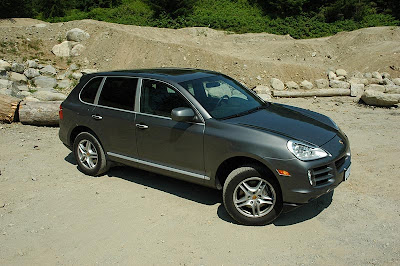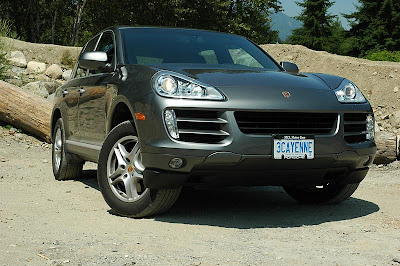Just over a half-decade old, the Porsche Cayenne provides a valuable real-world lesson about the business of building automobiles: a couple of lessons in fact.
First and foremost, the 2002 debut of the V8-powered Porsche SUV proved you could teach an old dog new tricks: the perennial sports car builder pulled off the improbable to design and produce a crackerjack luxury sport SUV right out of the gate.
Though a little late to that category, the Cayenne quickly caught the attention of the well-heeled looking for a little five-seater excitement, and by 2005 - just three years into production - the SUV became Porsche’s top selling model in North America with more than 100,000 units sold.
Even Porsche traditionalists, who were initially convinced Dr. Ferry Porsche was spinning in his grave at the very notion of a Porsche ‘truck,’ grudgingly grew to accept the Cayenne - though more for the fact its robust sales figures dramatically improved Porsche AG’s financial forecast - which meant the company would be making two-seaters well into the 21st Century (an outlook in the late-1990s that appeared unlikely). A second lesson gleaned from the Cayenne’s quick ascendancy is that the number of baby boomers willing to pay big dollars for a five-door fitted with an eight-cylinder Porsche engine thirstier than a tableful of mechanics on holiday in Bavaria, is limited.
A second lesson gleaned from the Cayenne’s quick ascendancy is that the number of baby boomers willing to pay big dollars for a five-door fitted with an eight-cylinder Porsche engine thirstier than a tableful of mechanics on holiday in Bavaria, is limited.
Porsche North America sold 13,607 Cayennes in 2005 (roughly 5,000 base models, 6,000 S models and 2,500 Turbos), easily outpacing Boxster and 911 sales. But that changed in 2006, as 911 sales ballooned to just over 12,000, combined Boxster and Cayman sales passed 11,500 and Cayenne numbers fell to 10,569.
Higher North American fuel prices, new sexy models from other luxury car builders and a slowing economy all contributed to slipping Cayenne sales.
Which begs the question: will 2005 be the high-water mark of the Porsche Cayenne? Or will the second-generation Cayenne, the 2008, get those boomers back in Porsche dealerships with chequebooks in hand?
Early indications for the 2008 model are promising, as Cayenne sales in North America for June were up 57 per cent over the previous year, while in Canada the improvement was 61 per cent. The final lesson here is one not yet formed, as the days are still early for the 2008 Cayenne.
The final lesson here is one not yet formed, as the days are still early for the 2008 Cayenne.
But with rumblings that Porsche is developing a smaller SUV model, called the Roxster, the long-term fate of the Cayenne hangs in the balance, with much of it dependent on the success of the ’08 Cayenne and possibly the rumoured-to-be-coming Cayenne Hybrid.
So, what have the brilliant engineering and design minds of Porsche done to improve their SUV? Not surprisingly, more muscle, both inside and out.
The first thing that strikes you about the 2008 Cayenne S is its striking snout. With headlight arrays like futuristic dragon’s eyes, a sensuously bulging hood subtly hinting at the power that lurks beneath, and muscular wheel arches, there is little doubt this beast is all Porsche all the time. As with the first generation, though, the aggressive and well-sculpted front end doesn’t flow through the rest of the body. Indeed, from some rear angles, the Cayenne looks as pedestrian a SUV as is out there (okay, minus the bad-ass, stainless steel exhaust pipes poking out from underneath).
As with the first generation, though, the aggressive and well-sculpted front end doesn’t flow through the rest of the body. Indeed, from some rear angles, the Cayenne looks as pedestrian a SUV as is out there (okay, minus the bad-ass, stainless steel exhaust pipes poking out from underneath).
Badass is the best way to describe the new V8 engines that power the three 2008 Cayenne models available in Canada. The base comes with a 290-hp, 3.6-litre engine with a reported 0-96 km/h time of 7.5 seconds; the S with a 385-hp, 4.8-litre clocked at 6.4 seconds; and the Turbo with a couple of turbochargers that boost the 4.8 litre’s horsepower to a monstrous 500 with a zero-to-96 km/h (60 mph) time of a mere 4.9 seconds. (For comparison’s sake, the 2008 911 Turbo Cabrio is said to achieve this from a standing stop in just 3.7 seconds). I guess the Cayenne Turbo is for the perennially late soccer mom.
All three engines utilize direct fuel injection, a first for the Cayenne, and all three objectives of the new fuel delivery system - reduced emissions, improved fuel consumption and increased power - have been achieved, though I’ll leave it to the reader to determine if a city L/100km rating of 16.3 (17 mpg) can fairly be called an ‘improvement.’ Still, Porsche’s claim of a 15 per cent improvement in the S and 11 per cent in the Turbo is definitely moving in the right direction. Like all guilty pleasures, hammering the Cayenne S on an open stretch of highway with the Sport button engaged puts all thoughts of saving the planet out of your mind, or at least until the next off-ramp. Sport button? Simply press the non-descript and oddly large button located below the gear shift on the centre console and engine output increases thanks to some high-falutin’ computer chip mapping. Make sure you’ve got both hands on the heated and leather-wrapped steering wheel though as the noticeable power surge can catch a driver unaware. This may be an SUV, but it also has a highly tuned Porsche power plant delivering plenty of pull throughout its power band.
Still, Porsche’s claim of a 15 per cent improvement in the S and 11 per cent in the Turbo is definitely moving in the right direction. Like all guilty pleasures, hammering the Cayenne S on an open stretch of highway with the Sport button engaged puts all thoughts of saving the planet out of your mind, or at least until the next off-ramp. Sport button? Simply press the non-descript and oddly large button located below the gear shift on the centre console and engine output increases thanks to some high-falutin’ computer chip mapping. Make sure you’ve got both hands on the heated and leather-wrapped steering wheel though as the noticeable power surge can catch a driver unaware. This may be an SUV, but it also has a highly tuned Porsche power plant delivering plenty of pull throughout its power band.
In addition to the more powerful engines, the biggest technological achievement on the second generation Cayenne is something called Porsche Dynamic Chassis Control, an ingenious system that controls and regulates the air suspension system (standard on the Turbo and optional on the base and S models).
Not only does the chassis control system significantly decrease body roll through tight corners (or for that matter, long sweepers) over the first generation Cayenne, it makes steering crisper and braking smoother. The reason Cayennes haven’t been wrapping themselves around telephone standards like those tail-happy Porsche Turbos of lore is simply stunning driving dynamics.
The dual-range all-wheel drive system is arguably one of the best in the business in this sort of application, and if you’ve got the nerve and bank manager’s blessing for it, an off-road excursion on some of Canada’s toughest logging roads is well within reason. Just make sure you swap off the low-profile speed rated Michelins for a meatier set of boots. Getting the new Cayenne a little dirty was obviously on the mind of cabin designers, as a rubberized and high-sided cargo floor is easy to wipe down with soap and water.
As to interior changes, the second generation is crammed full of all the typical luxury class cabin creature comforts. From 12-way adjustable heated leather front seats to a 14-speaker Bose sound system, and from a multifunctional steering wheel with gear shift buttons to an integrated carbon filter for the cabin’s environment, the 2008 Cayenne is what you’d expect from an SUV with a sticker price north of $75,000.
When it all comes down to it, it will be that sticker price that really determines the fate of the second-generation Cayenne and any new generations to come. It remains to be seen how many wealthy people still covet an SUV with the soul of a sports car.
BBC motoring guru Jeremy Clarkson summed this sentiment up well when he quipped about the original Cayenne, “just as no-alcohol lager defeats the objective, so does a Porsche off-roader.”
It turned out old Jeremy was a little off the mark there, as North American sales hit record proportions and the motoring public fell in love with the first generation Cayenne. The second generation does what is hoped of all offspring and betters its lineage in both power and performance.
Only time will tell if it can improve on the lofty sales figures its near ancestor set.